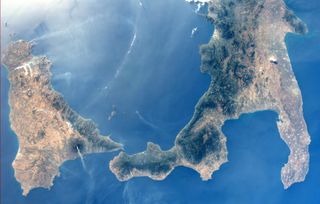Astronauts See Mount Etna Volcano's Lava and Steam from Space (Photos)

Two astronauts aboard the International Space Station have captured a one-two punch of incredible views from space of Mount Etna and another active volcano in Italy spewing steam and lava.
NASA astronaut Reid Wiseman and European Space Agency astronaut Alexander Gerst managed to photograph both Mount Etna and Mount Stromboli from their positions on the space station earlier this month. Gerst caught sight of the two Italian volcanoes and their lava flows at night, while Wiseman captured the mountains during daylight.
Both photos give viewers a different perspective of the massive volcanoes. The images were taken from the same angle, and thanks to that specific shot alignment, space fans can orient themselves to see the red lava flows in Gerst's photo. Without the context provided by Wiseman's daytime image, the lava would be much more difficult to spot. [See more space photos by Alexander Gerst]
"You can see the red glowing lava of 2 volcanoes on this photo!" Gerst wrote when he posted his photo on Twitter (@Astro_Alex). "Spot them on @astro_reid's day photo!"

"#Etna and #Stromboli erupting by day," Wiseman wrote in his Twitter (@Astro_Reid) post. "@astro_alex took the exact same shot at night, with lava. #teamwork."
Gerst has quite a bit of experience with volcanoes. Before flying to space, he was awarded his doctorate for research he did investigating volcanic eruptions and active volcanoes. While working toward his master's degree, Gerst also developed new techniques that could help scientistsbetter predict when volcanoes might erupt, according to ESA.
Mount Etna was actually the first erupting volcano Gerst climbed, according to a Twitter post sent out in July.
Get the Space.com Newsletter
Breaking space news, the latest updates on rocket launches, skywatching events and more!
Mt. Etna looks pretty active today! She was the first erupting #volcano I set foot on. #BlueDot pic.twitter.com/0r9riRQrpc
Mount Etna is the largest volcano in Europe, standing at 10,900 feet (3,328 meters) high. It is one of the most active volcanoes in the world, but it hasn't had a major eruption since 1992. The active volcano is almost always discharging gas, ash or lava.
This isn't the first time Mount Etna's active phase has been seen from space. NASA astronaut Karen Nyberg caught sight of the volcano from her post aboard the international Space Station in October 2013. That same year, Canadian astronaut Chris Hatfield also snapped an amazing image of the active volcano's ash floating through clouds and out to sea.
Both Gerst and Wiseman are about halfway through with their first spaceflight. They launched to the space station in May and are expected to return to Earth in November. Wiseman and Gerst are joined on the station by NASA astronaut Steve Swanson and three cosmonauts: Maxim Suraev, Oleg Artemyev and Alexander Skvortsov.
Follow Miriam Kramer @mirikramer and Google+. Follow us @Spacedotcom, Facebook and Google+. Original article on Space.com.
Join our Space Forums to keep talking space on the latest missions, night sky and more! And if you have a news tip, correction or comment, let us know at: community@space.com.

Miriam Kramer joined Space.com as a Staff Writer in December 2012. Since then, she has floated in weightlessness on a zero-gravity flight, felt the pull of 4-Gs in a trainer aircraft and watched rockets soar into space from Florida and Virginia. She also served as Space.com's lead space entertainment reporter, and enjoys all aspects of space news, astronomy and commercial spaceflight. Miriam has also presented space stories during live interviews with Fox News and other TV and radio outlets. She originally hails from Knoxville, Tennessee where she and her family would take trips to dark spots on the outskirts of town to watch meteor showers every year. She loves to travel and one day hopes to see the northern lights in person. Miriam is currently a space reporter with Axios, writing the Axios Space newsletter. You can follow Miriam on Twitter.
